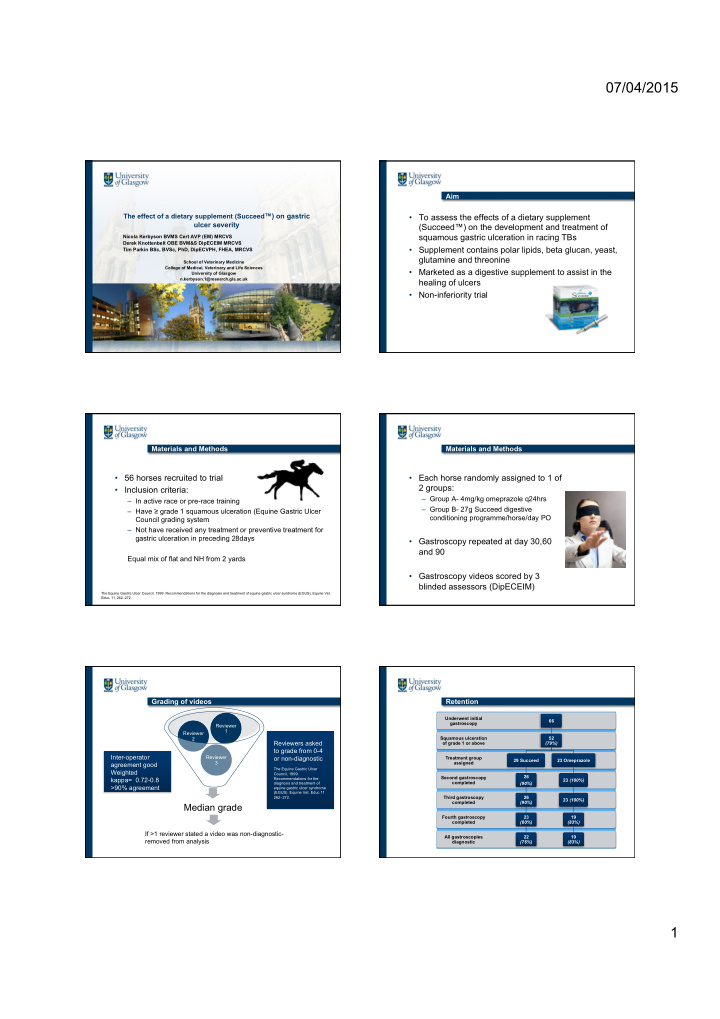



07/04/2015 Aim The effect of a dietary supplement (Succeed ™) on gastric • To assess the effects of a dietary supplement ulcer severity (Succeed™) on the development and treatment of squamous gastric ulceration in racing TBs Nicola Kerbyson BVMS Cert AVP (EM) MRCVS Derek Knottenbelt OBE BVM&S DipECEIM MRCVS • Supplement contains polar lipids, beta glucan, yeast, Tim Parkin BSc, BVSc, PhD, DipECVPH, FHEA, MRCVS glutamine and threonine School of Veterinary Medicine College of Medical, Veterinary and Life Sciences • Marketed as a digestive supplement to assist in the University of Glasgow n.kerbyson.1@research.gla.ac.uk healing of ulcers • Non-inferiority trial Materials and Methods Materials and Methods • 56 horses recruited to trial • Each horse randomly assigned to 1 of 2 groups: • Inclusion criteria: – Group A- 4mg/kg omeprazole q24hrs – In active race or pre-race training – Group B- 27g Succeed digestive – Have ≥ grade 1 squamous ulceration (Equine Gastric Ulcer conditioning programme/horse/day PO Council grading system – Not have received any treatment or preventive treatment for gastric ulceration in preceding 28days • Gastroscopy repeated at day 30,60 and 90 Equal mix of flat and NH from 2 yards • Gastroscopy videos scored by 3 blinded assessors (DipECEIM) The Equine Gastric Ulcer Council, 1999. Recommendations for the diagnosis and treatment of equine gastric ulcer syndrome (EGUS). Equine Vet. Educ. 11, 262–272. Grading of videos Retention Underwent initial 66 gastroscopy Reviewer 1 Reviewer Squamous ulceration 52 2 Reviewers asked of grade 1 or above (79%) to grade from 0-4 Inter-operator Reviewer or non-diagnostic Treatment group 29 Succeed 23 Omeprazole 3 assigned agreement good The Equine Gastric Ulcer Weighted Council, 1999. 26 Second gastroscopy kappa= 0.72-0.8 Recommendations for the 23 (100%) completed diagnosis and treatment of (90%) >90% agreement equine gastric ulcer syndrome (EGUS). Equine Vet. Educ 11 Third gastroscopy 26 262–272. 23 (100%) completed (90%) Median grade Fourth gastroscopy 23 19 completed (80%) (83%) If >1 reviewer stated a video was non-diagnostic- All gastroscopies 22 19 removed from analysis diagnostic (76%) (83%) 1
07/04/2015 Reasons for horses leaving trial Starting squamous ulcer grade Cardiac disease 2 2 4 Upper airway Squamous ulcer grade surgery 8 7 3 Tendon injury 9 8 2 Sold/moved yard 4 1 0 Omeprazole Succeed Results Non-inferiority analysis • Many clinical studies compare the effectiveness of two treatments rather than a treatment vs placebo • Historically when two treatments are compared to assess if they are significantly different from one another • This difference may be significant but not clinically relevant • Non-inferiority analysis includes an assessment of the clinical significance of the difference Non-inferiority analysis Statistical analysis- Day 0-90 • Chi 2 tests (Fishers exact) demonstrated no significant difference between the two groups in terms of improvement in squamous gastric ulcer grade at day 90 Group <2 grades ≥ 2 grades P value improvement improvement Succeed 20 4 0.72 Omeprazole 15 4 Group <1 grade ≥ 1grade P value improvement improvement Succeed 14 10 0.71 Omeprazole 10 9 2
07/04/2015 Summary of Chi 2 analysis McNemars • A significant effect of omeprazole was observed at ≥ 2 (Squamous) Day 0-30 Day 0-60 Day 0-90 day 30 in terms of improvement by 1 or 2 grades and Succeed 0.69 0.75 1.0 at day 60 in terms of improvement by 1 grade. Omeprazole 0.001 0.001 0.06 • There was no difference between treatments at day ≥ 3 (Squamous) Day 0-30 Day 0-60 Day 0-90 90 (neither treatment resulted in significant Succeed 0.55 0.51 1.0 improvement) Omeprazole 0.29 0.11 1.0 P values represent the likelihood that each treatment will result in a gastric ulcer score of ≥ 2 or ≥ 3 at the time point Results Withdrawal periods There was no statistically significant improvement in • Standard withdrawal periods applied to omeprazole severity of squamous ulceration with treatment at the throughout the trial label dosages for either omeprazole or Succeed™ • 11/20 horses in omeprazole group had withdrawal following 90 days of treatment. periods applied • No difference in likelihood of improving by 2 grades or more or having a grade of ≤ 2 at day 90 (Chi2) • The effect of the withdrawal time has been analysed by logistic regression- no difference Total and longest consecutive withdrawals Analysis of effect of withdrawal • However with so few observations of a positive outcome in the omeprazole group this may be underpowered • Hence … • Mann-Whitney non parametric tests performed which showed no significant difference in the total withdrawal or consecutive withdrawal times for either outcome measurement 3
07/04/2015 Acknowledgements Analysis of effect of withdrawal • Freedom Health for funding the trial • Looked at the effect of both the total withdrawal period and the longest number of consecutive • Dr Tim Parkin withdrawal days on • Professor Derek Knottenbelt – Likelihood of having a grade of 2 or less at day 90 • Sycamore Lodge and Troytown Greyabbey – Likelihood of improvement by 2 or more grades Veterinary Surgeons • Logistic regression with 4 combinations of outcome • The Irish Equine Centre and explanatory variables- none significant • However with so few observations of a positive outcome in the omeprazole group this may be underpowered Analysis of effect of withdrawal • No difference in effect of omeprazole in horses due to withdrawal – But- likely to be at least partially due to lack of horses with a positive outcome – Difficult to establish the true effect of withdrawal without having a control group with no withdrawal but there were none of these in the population studied 4
Recommend
More recommend